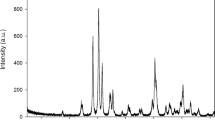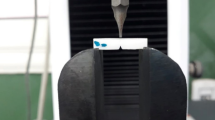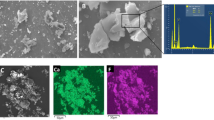Abstract
The aim was to synthesize an experimental adhesive (EA) and then reinforce it with β-tricalcium phosphate (β-TCP, 5 wt%) nanoparticles to yield β-TCP-5% adhesive. The EA and β-TCP nanoparticles were prepared and then integrated together. To characterize the filler nanoparticles, scanning electron microscopy (SEM), Energy Dispersive X-Ray (EDX) spectroscopy, Fourier-transform infrared (FTIR) spectroscopy, and micro-Raman spectroscopy techniques were utilized. Adhesive was assessed for push-out bond strength with yttria-stabilized tetragonal zirconia polycrystalline (Y-TZP) ceramic posts. The Y-TZP posts were cemented in to root dentin of 20 teeth (n = 20). The adhesives were further evaluated for inter-facial failure types and rheological properties. On SEM micrographs, the β-TCP nanoparticles were seen as non-uniform agglomerates. The EDX mapping demonstrated calcium and phosphate ions presence for the β-TCP-5% group. The FTIR and micro-Raman spectra(s) indicated characteristic bands for β-TCP. The β-TCP-5% adhesive demonstrated higher coronal and apical push-out bond strength values (9.80 ± 1.51 MPa and 8.53 ± 1.46 MPa, respectively) than the EA group. The majority of the failures (> 80%) for both groups were of adhesive-dentin type. The β-TCP-5% adhesive also revealed similar rheological properties to the EA, although the latter had less viscosity than the former. The reinforcing of EA with β-TCP filler nanoparticles ensued an appreciation of the adhesive’s push-out bond strength. However, β-TCP-5% adhesive demonstrated reduced viscosity compared to the EA. Further studies exploring the influence of diverse filler concentrations on different properties of the adhesive are recommended.





Similar content being viewed by others
Availability of data and material
Not applicable.
Code availability
Not applicable.
References
Abduljabbar T, Sherfudhin H, AlSaleh SA, Al-Helal AA, Al-Orini SS, Al-Aql NA (2012) Fracture resistance of three post and core systems in endodontically treated teeth restored with all-ceramic crowns. King Saud Univ J Dent Sci 3(1):33–38
Abou Neel EA, Bozec L, Perez RA, Kim HW, Knowles JC (2015) Nanotechnology in dentistry: prevention, diagnosis, and therapy. Int J Nanomed 10:6371–6394
Abou Neel EA, Aljabo A, Strange A, Ibrahim S, Coathup M, Young AM et al (2016) Demineralization-remineralization dynamics in teeth and bone. Int J Nanomed 11:4743–4763
AlFawaz YF, Almutairi B, Kattan HF, Zafar MS, Farooq I, Naseem M et al (2020) Dentin bond integrity of hydroxyapatite containing resin adhesive enhanced with graphene oxide nano-particles—an SEM, EDX, micro-Raman, and microtensile bond strength study. Polymers (Basel) 12:2978
Al-Hamdan RS, Almutairi B, Kattan HF, Alsuwailem NA, Farooq I, Vohra F et al (2020) Influence of hydroxyapatite nanospheres in dentin adhesive on the dentin bond integrity and degree of conversion: a scanning electron microscopy (SEM), Raman, fourier transform-infrared (FTIR), and microtensile study. Polymers (Basel) 12:2948
AlHamdan EM, Al-Saleh S, AlRefeai MH (2021) Adhesive bond integrity of Y-TZP post with calcium fluoride infiltrated resin dentin adhesive: An SEM, EDX, FTIR and micro-Raman study. Surf Interface Anal 53(11):956–962
Alhussain AM, Alhaddad AA, Ghazwi MM, Farooq I (2018) Remineralization of artificial carious lesions using a novel fluoride incorporated bioactive glass dentifrice. Dent Med Probl 55:379–382
Almutairi B, Kattan HF, BinMahfooz AM, Qutub OA, Basunbul G, ArRejaie AS et al (2021) Synergistic effect of graphene oxide/calcium phosphate nanofiller in a dentin adhesive on its dentin bond integrity and degree of conversion. A scanning electron microscopy, energy dispersive X-ray spectroscopy, Fourier transform infrared, micro-Raman, and bond strength study. Microsc Res Technol 84(9):2082–2094
Alqarawi FK, Alkahtany MF, Almadi KH, Ben Gassem AA, Alshahrani FA, AlRefeai MH et al (2021) Influence of different conditioning treatments on the bond integrity of root dentin to RGO infiltrated dentin adhesive SEM, EDX, FTIR and MicroRaman study. Polymers (Basel) 13:1555
AlRefeai MHA, Al-Saleh S, Alqahtani AS, Al-Rifaiy MQ, Alshiddi IF, Farooq I, Vohra F, Abduljabbar T (2021a) Application of β-tricalcium phosphate in adhesive dentin bonding. Polymers (Basel) 13:2285
AlRefeai MH, AlHamdan EM, Al-Saleh S, Farooq I, Abrar E, Vohra F, Abduljabbar T (2021b) Assessment of bond integrity, durability, and degree of conversion of a calcium fluoride reinforced dentin adhesive. Polymers (Basel) 13(15):2418
Al-Saleh S, Alateeq A, Alshaya AH, Al-Qahtani AS, Tulbah HI, Binhasan M, Shabib S, Farooq I, Vohra F, Abduljabbar T (2021) Influence of TiO2 and ZrO2 nanoparticles on adhesive bond strength and viscosity of dentin polymer: a physical and chemical evaluation. Polymers (Basel) 13(21):3794
Al-Sanabani JS, Madfa AA, Al-Sanabani FA (2013) Application of calcium phosphate materials in dentistry. Int J Biomater 2013:876132
Andrei M, Vacaru RP, Coricovac A, Ilinca R, Didilescu AC, Demetrescu I (2021) The effect of calcium-silicate cements on reparative dentinogenesis following direct pulp capping on animal models. Molecules 26:2725
Arbez B, Libouban H (2017) Behavior of macrophage and osteoblast cell lines in contact with the beta-TCP biomaterial (beta-tricalcium phosphate). Morphologie 101:154–163
Bin-Shuwaish M, AlHussaini A, AlHudaithy L, AlDukhiel S, AlJamhan A, Alrahlah A (2021) Effects of different antibacterial disinfectants on microleakage of bulk-fill composite bonded to different tooth structures. BMC Oral Health 21(1):1–9
Bohner M, Santoni BLG, Dobelin N (2020) Beta-tricalcium phosphate for bone substitution: synthesis and properties. Acta Biomater 113:23–41
Bolhuis HP, de Gee AJ, Pallav P, Feilzer AJ (2004) Influence of fatigue loading on the performance of adhesive and nonadhesive luting cements for cast post-and-core buildups in maxillary premolars. Int J Prosthodont 17:571–576
Farooq I, Bugshan A (2020) The role of salivary contents and modern technologies in the remineralization of dental enamel: a narrative review. F1000J 9:171
Farooq I, Ali S, Al-Saleh S, AlHamdan EM, AlRefeai MH, Abduljabbar T et al (2021) Synergistic effect of bioactive inorganic fillers in enhancing properties of dentin adhesives a review. Polymers (Basel) 13:2169
Federation FDIWD (2017) FDI policy statement on Minimal Intervention Dentistry (MID) for managing dental caries: adopted by the General Assembly: September 2016, Poznan, Poland. Int Dent J 67:6-7
Ferracane JL (2017) Models of caries formation around dental composite restorations. J Dent Res 96:364–371
Garcia IM, Leitune VCB, Samuel SMW, Collares FM (2017) Influence of different calcium phosphates on an experimental adhesive resin. J Adhes Dent 19:379–384
Guerrero-Girones J, Alcaina-Lorente A, Ortiz-Ruiz C, Ortiz-Ruiz E, Pecci-Lloret MP, Ortiz-Ruiz AJ et al (2021) Biocompatibility of a HA/beta-TCP/C scaffold as a pulp-capping agent for vital pulp treatment: an in vivo study in rat molars. Int J Environ Res Public Health 18:3936
Hamba H, Nakamura K, Nikaido T, Tagami J, Muramatsu T (2020) Remineralization of enamel subsurface lesions using toothpaste containing tricalcium phosphate and fluoride: an in vitro microCT analysis. BMC Oral Health 20:292
Hardan L, Bourgi R, Kharouf N, Mancino D, Zarow M, Jakubowicz N, Cuevas-Suárez CE et al (2021) Bond strength of universal adhesives to dentin: a systematic review and meta-analysis. Polymers 13(5):814
Heydecke G, Butz F, Hussein A, Strub JR (2002) Fracture strength after dynamic loading of endodontically treated teeth restored with different post-and-core systems. J Prosthet Dent 87:438–445
Huigen L, Xuekang P, Minjie H et al (2021) Fabrication of graphene/gelatin/chitosan/tricalcium phosphate 3D printed scaffolds for bone tissue regeneration applications. App Nanoscience 11:335–346
Jaddalannagari S, Deshmukh K, Ramanan SR et al (2013) Antimicrobial activity of hemocompatible silver doped hydroxyapatite nanoparticles synthesized by modified sol–gel technique. Appl Nanosci 4:133–141
Jasser RA, AlSubaie A, AlShehri F (2021) Effectiveness of beta-tricalcium phosphate in comparison with other materials in treating periodontal infra-bony defects around natural teeth: a systematic review and meta-analysis. BMC Oral Health 21:219
Jeong J, Kim JH, Shim JH, Hwang NS, Heo CY (2019) Bioactive calcium phosphate materials and applications in bone regeneration. Biomater Res 23:4
Jindal S, Jindal R, Gupta K, Mahajan S, Garg S (2013) Comparative evaluation of the reinforcing effect of different post systems in the restoration of endodontically treated human anterior teeth at two different lengths of post space preparation- an in vitro study. J Dent (Tehran) 10:124–133
Kang KR, Piao ZG, Kim JS, Cho IA, Yim MJ, Kim BH et al (2017) Synthesis and characterization of beta-tricalcium phosphate derived from Haliotis sp. shells. Implant Dent 26:378–387
Lee JH, Um CM, Lee IB (2006) Rheological properties of resin composites according to variations in monomer and filler composition. Dent Mater 22:515–526
Majeed A, AlShwaimi E (2017) Push-out bond strength and surface microhardness of calcium silicate-based biomaterials: an in vitro study. Med Princ Pract 26:139–145
Mehdawi IM, Young A (2013) Antibacterial composite restorative materials for dental applications. In: Non-metallic biomaterials for tooth repair and replacement. Woodhead Publishing, pp 270–293
Mehdikhani BBG (2014) Densification and mechanical behavior of β-tricalcium phosphate bioceramics. Int Lett Chem Phys Astron 36:37–49
Noorani TY, Luddin N, Rahman IA, Masudi SM (2017) In vitro cytotoxicity evaluation of novel nano-hydroxyapatite-silica incorporated glass ionomer cement. J Clin Diagn Res 11:ZC105–ZC9
Ottl P, Hahn L, Lauer H, Fay M (2002) Fracture characteristics of carbon fibre, ceramic and non-palladium endodontic post systems at monotonously increasing loads. J Oral Rehabil 29:175–183
Özcan M, Volpato CAM (2020) Current perspectives on dental adhesion (3): adhesion to intraradicular dentin: concepts and applications. Jpn Dent Sci Rev
Perdigao J (2010) Dentin bonding-variables related to the clinical situation and the substrate treatment. Dent Mater 26:e24-37
Perdigao J (2020) Current perspectives on dental adhesion: (1) Dentin adhesion—not there yet. Jpn Dent Sci Rev 56:190–207
Pneumans M, Kanumilli P, De Munck J, Van Landuyt K, Lambrechts P, Van Meerbeek B (2005) Clinical effectiveness of contemporary adhesives: a systematic review of current clinical trials. Dent Mater 21:864–881
Qualtrough AJ, Mannocci F (2003) Tooth-colored post systems: a review. Oper Dent 28:86–91
Ruiz-Aguilara CO-PU, Aguilar-Reyes EA, López-Juárez R, Alfonso I (2018) Characterization of β-tricalcium phosphate powders synthesized by sol-gel and mechanosynthesis. Bol Soc Esp Ceram Vidr 57:213–220
Sabatini C, Pashley DH (2014) Mechanisms regulating the degradation of dentin matrices by endogenous dentin proteases and their role in dental adhesion. A review. Am J Dent 27:203–214
Schiroky PR, Garcia IM, Noal FC et al (2021) Adhesive system with alpha-tricalcium phosphate addition for mineral deposition on caries-affected dentin. Int J Adhes Adhes 105:102790
Shen P, Bagheri R, Walker GD, Yuan Y, Stanton DP, Reynolds C et al (2016) Effect of calcium phosphate addition to fluoride containing dental varnishes on enamel demineralization. Aust Dent J 61:357–365
Shin H, Ko H, Kim M (2016) Cytotoxicity and biocompatibility of Zirconia (Y-TZP) posts with various dental cements. Restor Dent Endod 41:167–175
Tavassoli-Hojjati S, Atai M, Haghgoo R, Rahimian-Imam S, Kameli S, Ahmaian-Babaki F et al (2014) Comparison of various concentrations of tricalcium phosphate nanoparticles on mechanical properties and remineralization of fissure sealants. J Dent (Tehran) 11:379–388
Van Meerbeek B, Yoshihara K, Yoshida Y, Mine A, De Munck J, Van Landuyt KL (2011) State of the art of self-etch adhesives. Dent Mater 27:17–28
Wagner A, Belli R, Stotzel C, Hilpert A, Muller FA, Lohbauer U (2013) Biomimetically- and hydrothermally-grown HAp nanoparticles as reinforcing fillers for dental adhesives. J Adhes Dent 15:413–422
Zhang X, Zhang Q, Meng X et al (2021) Rheological and mechanical properties of resin-based materials applied in dental restorations. Polymers (Basel) 13:2975
Zhou W, Liu S, Zhou X, Hannig M, Rupf S, Feng J et al (2019) Modifying adhesive materials to improve the longevity of resinous restorations. Int J Mol Sci 20:723
Acknowledgements
The authors are grateful to the Researchers supporting project at King Saud University for funding through Researchers supporting project no. (RSP-2021-44).
Author information
Authors and Affiliations
Contributions
Conceptualization, HIT, ASA, MMA and FV; methodology, ASA, HIT, MB and FV; validation, MMA, FV, ASA, IF, and TA; formal analysis, ASA, MB, MMA, and FV; investigation, ASA, HIT, AA, and FV; data curation, MB, MMA, and FV; writing—original draft preparation, IF, FV, MB, and TA; writing—review and editing, HIT, ASA, IF, FV, and TA; supervision, FV, and TA funding acquisition, TA. All authors have read and agreed to the published version of the manuscript.
Corresponding author
Ethics declarations
Conflict of interest
None.
Ethics approval
The research ethics review committee of Specialist dental and research center approved the study protocol with No. UDRC-011/2020. All the recommendations of the Helsinki Declaration and its later amendments were strictly followed.
Consent to participate
Written informed consent from the patients whose extracted teeth were involved in this study was obtained.
Consent for publication
Written informed consent from the patients whose extracted teeth were involved in this study regarding publication of the results was obtained.
Additional information
Publisher's Note
Springer Nature remains neutral with regard to jurisdictional claims in published maps and institutional affiliations.
Rights and permissions
About this article
Cite this article
Al-Qahtani, A.S., Tulbah, H.I., Binhasan, M. et al. Nano-β-tricalcium phosphate incorporated root dentin adhesive in the bonding interface of yttria-stabilized tetragonal zirconia polycrystalline post. Appl Nanosci 12, 3489–3498 (2022). https://doi.org/10.1007/s13204-022-02355-3
Received:
Accepted:
Published:
Issue Date:
DOI: https://doi.org/10.1007/s13204-022-02355-3




